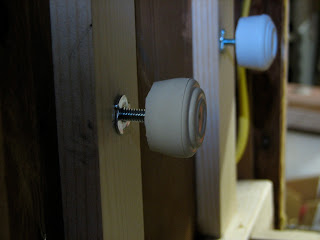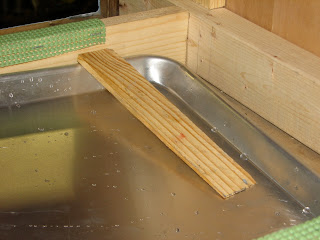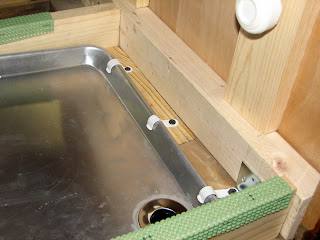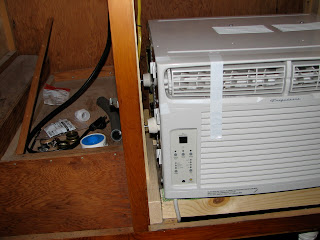 |
| (Sorry this picture is supposed to be after the intro but I can't get it to stay there) This is the fan I installed directly behind the a/c unit to pull the hot air out. |
After installing the a/c unit and drain pan, I began addressing how to vent the area the a/c unit is enclosed in. I knew I needed to prevent the unit from over heating. When you're looking at upper 90's, 100% humidity, and heat indexes well over a 100 degrees, your a/c better work. It gets HOT in Alabama! It took me a couple of times to get it right. First, I just stuck a fan behind the unit to pull the hot air out the access door. This worked okay, but the wood paneling became hot to the touch and it didn't cool well. Then I tried turning the fan around (to pull fresh air in) and put fans in a vent located directly above the access door (to pull hot air out). This didn't work at all. The compressor would kick off in about 15 minutes. Next, I set it up as described in this post. It works great! The wood panelling right next to the unit doesn't even get warm. And, it keeps the trailer cool even in the upper 90's.
 |
| Next, I drilled holes in the shelf the fridge will sit on. This is to draw fresh air in through the top vent (the vent above the access door). |
 |
| I installed two small fans in the holes. The fans air flow blows down into the compartment where the a/c unit is located. I used fans designed to use in computers. Where I originally had them installed, I needed very small fans which would pull a lot of air. With the fans installed in this location, I probably could have used something different. I bought these at Radio Shack and they were expensive. |
 |
| This is the compartment where the a/c unit sits. You can see the fans at the top of the picture. When I had to redo the ventilation, I had to take the a/c unit back out. |
 |
| This is the view of the fans from above. The fridge will sit here. |
 |
| I moved back a little for a better view. The fridge will sit on the top shelf and the a/c unit sits on the bottom. |
 |
| I had to add a piece of paneling to separate the fridge area from where we hang our clothes in the closet. I installed some wood strips in the closet to attach the panel to. This is the bottom piece. |
 |
| If you don't have a right angle drill, buy one. I used mine more than my standard drill. I like the rigid brand because you can register your tools and get a life time warranty. The warranty covers the tool and the battery. The battery warranty is what makes the deal. |
 |
| This is a test fit of the panel. This is the inside of the closet. You can barely see the clothes bar at the top of the picture. |
 |
| This is a picture of the same panel but from the other side. This outlet is for powering my fridge and the two small ventilation fans installed under the fridge shelf. In an earlier post (Adding a/c: running the power), I mention a yellow cable running to the top of the closet for the fridge. This is where it ends up. |
 |
| I wanted to be able to turn the two vent fans under the fridge shelf on and off. In the winter it would cause cold drafts. This is a picture of a small outlet box I installed in the back of the closet for an on / off switch. |
 |
| This is a picture from the other side. |
 |
| I ran some lamp wiring (with a plug already attached) through the box. |
 |
| This is the cover plate and switch I plan to use. |
 |
| I wired the switch to the fans. You can also see where the fridge will be installed |
 |
| This is the installed switch in the back of the closet. |
 |
| This is an exterior view of the vent located directly above the assess door to the a/c unit. I don't know what it was originally intended for. Mine was sealed off with a piece of plywood. You can see the wasp nests. This is wear the fresh air enters behind the fridge. I removed the plywood (and the wasp nests). |
 |
| This an interior view of the above vent. I had a screen made and installed it to keep the bugs out. |
 |
| Finished up wiring the two vent fans and the switch. I just followed the directions that came with the fans. |
 |
| Here's bigger view. Please note: the fans are pictured in their original location. There's a picture earlier in this post showing the correct location. The next couple of posts will address permanently installing the fridge and a/c unit. |




















































